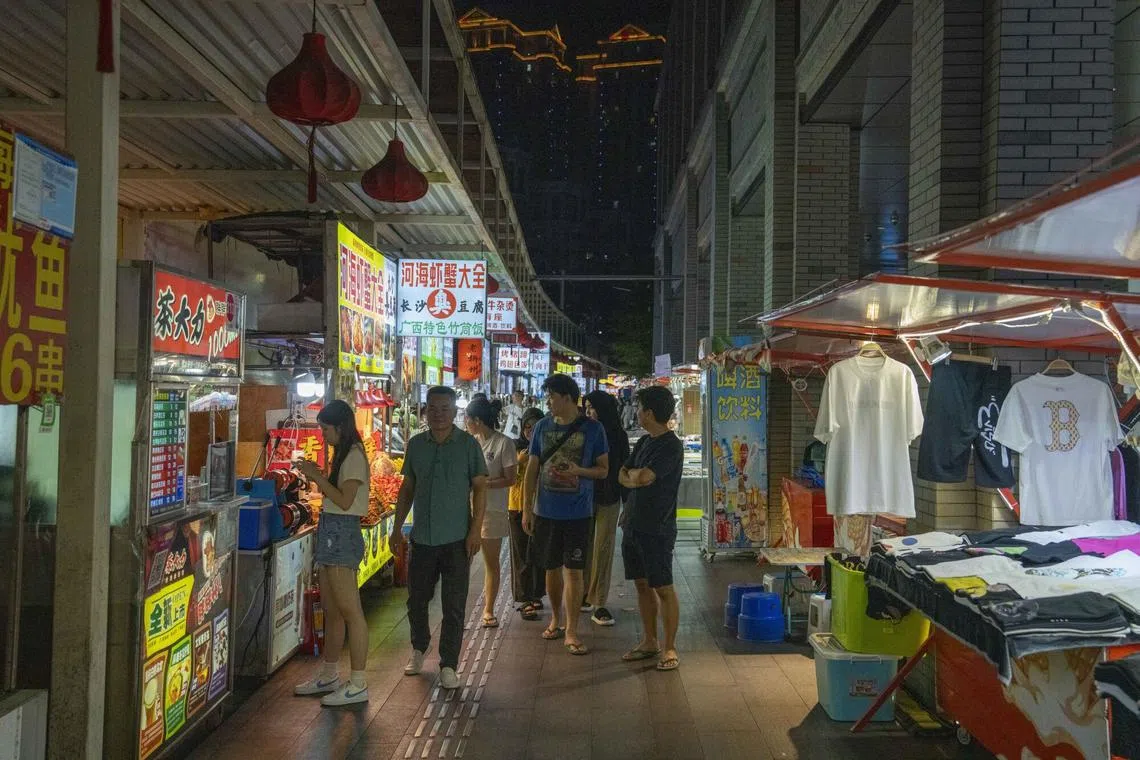China rebound gets more lopsided as factories hum, shoppers lag
Sign up now: Get ST's newsletters delivered to your inbox

Retail sales rose 2.3 per cent, lower than 3.1 per cent in March and worse than the 3.7 per cent expected.
PHOTO: BLOOMBERG
Follow topic:
BEIJING - China’s retail sales grew at the slowest pace since 2022 while industrial production accelerated, highlighting the unbalanced recovery of the world’s second-largest economy.
Retail sales rose 2.3 per cent in April, China’s National Bureau of Statistics (NBS) said on May 17.
That is down from 3.1 per cent in March, and worse than the 3.7 per cent predicted by economists in a Bloomberg survey.
Industrial output rose 6.7 per cent in April from a year ago, faster than the median estimate of 5.5 per cent.
China’s export-driven manufacturing sector has powered the economy in 2024, as a housing crisis continues to weigh on domestic demand.
Exports returned to growth in April, and factory activity expanded for a second month. But consumer prices remained sluggish, and credit shrank for the first time since 2005.
“My biggest takeaway is that China is having a two-speed recovery,” said Mr Larry Hu, head of China economics at Macquarie Group.
He said the mixed data may spur the government to step up support on the margin but will not lead to any major shift.
Other data published on May 17 also showed a diverging economy. Fixed-asset investment grew 4.2 per cent in the first four months of 2024, a mild slowdown from the previous numbers. But investment in property development plunged 9.8 per cent. The urban jobless rate was 5 per cent, down from 5.2 per cent as at the end of March.
“Overall, the economy operated stably in April,” NBS spokeswoman Liu Aihua said in a briefing, attributing the slowing indicators to base and seasonal effects.
“New growth drivers are maintaining a fast growth and the economy continued its recovering and improving trend.”
The bureau cited the “increasingly complex, grim and uncertain” external environment among challenges ahead, and called for the early implementation of existing macroeconomic policies.
The anaemic consumption growth may add urgency to Beijing’s plan to encourage companies and households to upgrade their machines and appliances. The roll-out of modest subsidies began late in April across cities, including some to help fund car purchases.
“The effect of the new-for-old programme for consumer goods is yet to kick in,” said Mr Bruce Pang, chief economist for Greater China at Jones Lang LaSalle, adding that the uncertain economic outlook may deter spending. “In general, consumers’ expectations are yet to turn the corner.”
Auto sales were one of the biggest drags on spending, sliding 5.6 per cent from a year earlier in the deepest drop in more than a year. China’s carmakers are engaged in a price war that may be encouraging consumers to delay purchases.
Sales of clothing, shoes, hats and textile declined 2 per cent from a year earlier, the first contraction since the end of 2022.
President Xi Jinping’s government has signalled that more support is coming. Beijing will start selling its one trillion yuan (S$186 billion) ultra-long special sovereign bonds on May 17, which could fund infrastructure spending critical to growth. That has spurred expectations of monetary easing to help banks buy the notes.
Other risks remain. The Communist Party’s focus on ramping up China’s clean energy sectors has stoked tensions overseas, with the US and EU complaining a deluge of cheap goods is threatening jobs in their domestic markets. The Biden administration has unveiled a 100 per cent tariff on electric vehicles. BLOOMBERG

